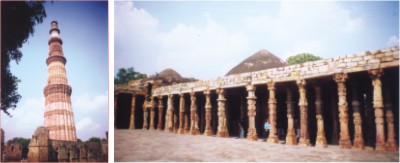Feature
Qutb complex: The silent
witness of antiquity
Wrishi Thakur Raphael
 THE monuments of Qutb Complex heralds a period in history of more then 1100years. (Between 4th-13th century AD). During this period many dynasties have come & gone, great battles fought & history written & rewritten by gallant warriors of antiquity. But what captures ones imagination is how Mehrauli (another name for the Qutb Complex) with all its diversity & complexity of origin exhibit such a mystical harmony. The Qutb Complex is one of Delhi's most distinctive & astonishing spots as one will find the merging of both Hindu & Islamic styles of architectural splendor. The star features of Mehrauli: THE monuments of Qutb Complex heralds a period in history of more then 1100years. (Between 4th-13th century AD). During this period many dynasties have come & gone, great battles fought & history written & rewritten by gallant warriors of antiquity. But what captures ones imagination is how Mehrauli (another name for the Qutb Complex) with all its diversity & complexity of origin exhibit such a mystical harmony. The Qutb Complex is one of Delhi's most distinctive & astonishing spots as one will find the merging of both Hindu & Islamic styles of architectural splendor. The star features of Mehrauli: Qutb Minar:
The 234ft high minar is the tallest individual tower in the world. The five storied Victory Tower was started by Qutubuddin Aibak & completed by his successor Iltutmish between 1206-1210. Qutubuddin, who was originally a slave general of Muhammed of Ghur later, became the man who founded the first Muslim dynasty in North India. Mohammed of Ghur was a mighty king who established control in Delhi & Punjab after defeating Prithviraj Chauhan in1192.
There are 378 steps that lead to the roof of the tower- a very strenuous climb indeed. Once on top one may enjoy the most picturesque view of Delhi which includes Humayun's Tomb, Mehrauli village & Dilkusha Gardens. For the far-reaching view from its roof the kings of old would climb to the top of the tower to spot the position of incoming enemy; thus allowing them to plan for skirmishes in advance. The superb stone carvings of the minar exhibit a style typical of Islamic masonry.
Quwwat ul-Islam Mosque
A mosque of mixed origins as the bells & garlands on the pillars of the mosque are clearly Hindu motifs but the domes & arches of this splendid mosque are typically Islamic in nature.
Iron Pillar:
This 4th century pillar was built during the Gupta dynasty is probably the oldest of all structures in the Qutb Complex. The Gupta period (320-500AD) saw north India flourish in fields of art , music culture & architecture, evidence of which is the Nalanda Buddhist University. The iron pillar was raised as homage to the Lord Vishnu- the Hindu God of Preservation.
Alai Darwaza:
This gateway to the complex, erected in 1311 by Alauddin Khilji, is probably among the oldest buildings in India which exhibits the Islamic pattern of arches. The Khiljis were a breed of mighty warriors who conquered Gujrat, Rajasthan & Bengal.
Delhi: India's 'Dil' has witnessed many annexations, battles, creation of magnificent monuments & fascinating tales of bravery, hardship, betrayal & horror. All the great emperors who were privileged by its throne wanted to preserve it, but eventually time took away their supremacy. But what time has failed to do is to erase their mementoes, their legacies which are so vibrant a part of India's history. The most unique collection of such mementoes in my opinion is Qutb Complex as an array of events occurring over thousand years is linked to its existence. If one is to unfold the scrolls of Delhi's history Mehrauli will relate to that history in its own exclusivity.
| 